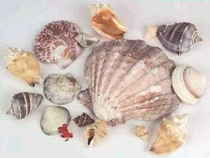Oregon State Shell
Oregon Hairy Triton

(Fusitriton oregonensis)
Adopted in October 1, 1989.
The "Oregon Hairy Triton", (Fusitriton oregonesis,) was declared the state seashell in 1989 by the Sixty-fifth Legislative Assembly of Oregon.
The Oregon hairy triton, (Fusitriton oregonensis,) is a species of large predatory sea snail, a marine gastropod mollusk in the family Ranellidae, the tritons.
Oregon State Shell: Oregon Hairy Triton

The "Oregon Hairy Triton" was named after a conchologist (shell expert) named Redfield in 1848, after the Oregon Territory. This shell is the largest in the state, and reaches lengths of up to five inches. They wash up on the Oregon coast during high tides.
This mollusk member of the Gastropod Class (snails, slugs, welks, abalones) grows to about 5 inches long. It is a light brown and covered with gray-brown
bristles, hence the name "hairy". The shell is basically an elongate cone wound around an axis. Each turn around the axis constitutes a whorl. In the
case of the Oregon Hairy Triton, there are 6 whorls in its shell. The Oregon Hairy Triton is usually found on rock bottoms in shallow water from Alaska
to southern California (hence, we do find them in Smitty's Cove.) Occasionally, they use softer bottoms and may go as deep as 600 feet. Because of
their rather non-descript appearance, they are sometimes easy to miss as a diver glides along over the bottom. They are an aggressive predator on other
mollusks and sea urchins. These are carnivorous snails, and feed on sea urchins, or, if urchins aren't around, they scavenge whatever they can
find.
According to Greek Mythology, Triton was a merman (half man), and demigod of the sea (half fish). Triton dwelt with his parents, the sea god Poseidon
and his wife Amphitrite, in a golden palace under the sea.
Centuries later, Triton's name was applied to a family of marine gastropods, or snails. They were so named because holes were sometimes drilled in
larger specimens where were then used as horns, similar to the shell trumpet Triton carried.
Ecology
The Oregon triton is a common subtidal species of marine snail found from southern Califor-nia to the Gulf of Alaska and to the eastern Bering Sea.
It occurs occasionally intertidally and is com-mon to 140 fm on rock, sand, shell, or gravel sub-strate.
One of the Neptune species off Oregon, N. humboldtiana, is found from central California to southern British Columbia in depths from 100-250 fm. Its
habitat may be on sand, muddy sand, and mud bottoms.
Baird's topsnail is found from Mexico to Alaska in depths of 50-300 fm.
Reproduction
Many of the marine snails have similar live histories. The sexes are separate but similar in appearance and fertilization is internal. Eggs capsules
are laid, from which crawling young are hatched. Capsules are laid in clusters on rock surfaces or on the shells of other snails, the same or different
species. Egg clusters vary in size, shape, color, and number of individual capsules. The mortality rate of eggs is usually high, therefore the eggs
are laid in very large numbers.
The Oregon triton exhibits a courting behavior beginning approximately six months prior to egg laying. Pairing of "couples" may begin in the winter
with egg laying in the summer. By mid-summer, the pairs break up. The eggs or "sea corn" are laid one by one in an ever widening circle. The triton
will brood their eggs for a period of eight to nine weeks, until all are hatched to protect them from being eaten by other invertebrates, especially
urchins and other Oregon tritons. Unlike the other species, larvae of the Oregon triton are pelagic.
Food and Growth
Most of these snails are probably carnivores and scavengers. The Oregon triton is probably nocturnal and feeds on a variety of invertebrates by
immobilizing the prey with secretions from the proboscis gland.
A female Oregon triton is usually larger than its mated male.
Among the large Neptunea, sexual maturity occurs at a shell length of 90-110 mm, which probably corresponds to about 10 years of age. N. humboldtiana,
is noted for its thin shell and is therefore lighter is weight for its size than other Neptune species and also breaks easily.
Oregon House Concurrent Resolution 9
Sponsored by Representatives FORD, AGRONS, HANLON, Senator PHILLIPS (at the request of Margaret Teskey, Librarian, Oregon Society
of Conchologists)
Whereas triton shells were named after the sea demigod Triton, official trumpeter of Neptune, god of the sea, and Triton's name became attached to
the shell he blew as his trumpet and spread to become the name of a whole genus; and
Whereas the tritons are a stately family of snails whose shells have attracted the attention of humankind for many centuries; and
Whereas the Oregon Triton (Fusitriton oregonensis) is sometimes over five inches long with rounded whorls of white shell covered, when living, with
a brown, hairy layer called periostracum; and
Whereas the Oregon Triton, though it ranges in habitat from the Bering Sea to the Mexican border and northern Japan, is one of the larger snails of
the Pacific Northwest and the Pacific Northwest's representative of the triton family; now, therefore,
Be It Resolved by the Legislative Assembly of the State of Oregon:
That we, the members of the Sixty-fifth Legislative Assembly, recognize and proclaim the Oregon Triton (Fusitrition oregonensis) as the official Oregon
shell.
Oregon Law
The law designating the Oregon Triton as the official Oregon state shell is found in the Oregon Revised Statutes Edition, Title 19, Chapter 186
TITLE 19 MISCELLANEOUS MATTERS RELATED TO GOVERNMENT AND PUBLIC AFFAIRS
186. State Emblems; State Boundary
CROSS-REFERENCES.
Oregon Triton declared to be official shell, HCR 9 (1989)
Taxonomic Hierarchy: Oregon Triton
Kingdom: Animalia
Phylum: Mollusca
Class: Gastropoda --- snails, slugs, welks, abalones
Order: Caenogastropoda
Superfamily: Cymatiacea
Family: Ranellidae
Genus: Fusitriton
Species: Fusitriton oregonensis galea








